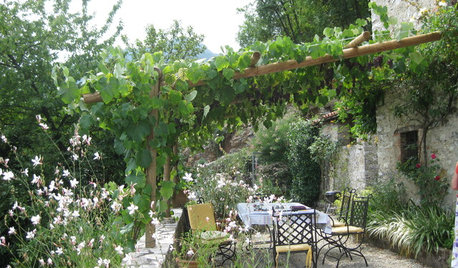which meal?
kossetx
16 years ago
Related Stories

ENTERTAININGGot Hand-Me-Down Dinnerware? Make a Memorable Meal
They might be mismatched and not your style, but those inherited plates and forks can help bring meaning to your table
Full Story
KITCHEN DESIGNOpen vs. Closed Kitchens — Which Style Works Best for You?
Get the kitchen layout that's right for you with this advice from 3 experts
Full Story
KITCHEN ISLANDSWhich Is for You — Kitchen Table or Island?
Learn about size, storage, lighting and other details to choose the right table for your kitchen and your lifestyle
Full Story
KITCHEN DESIGN12 Great Kitchen Styles — Which One’s for You?
Sometimes you can be surprised by the kitchen style that really calls to you. The proof is in the pictures
Full Story
FURNITUREWhich Dining Table Shape Should You Choose?
Rectangular, oval, round or square: Here are ways to choose your dining table shape (or make the most of the one you already have)
Full Story
LIFESimple Pleasures: Dinner for One
Make a solo meal a luxurious experience by savoring the moment along with whatever you cook
Full Story
GARDENING AND LANDSCAPINGRomantic Outdoor Dining Inspiration
Set the Table for a Meal Under the Stars
Full Story
HOME TECHHarness the Cloud: 8 Ways to Automate Your Housekeeping
Make life easier by scheduling regular deliveries, managing appliances, simplifying meal planning and more via the web
Full Story
ORGANIZINGDo It for the Kids! A Few Routines Help a Home Run More Smoothly
Not a Naturally Organized person? These tips can help you tackle the onslaught of papers, meals, laundry — and even help you find your keys
Full Story
LANDSCAPE DESIGNRecipe for Mediterranean Edible Garden Style
The only thing better than a delicious meal outdoors is the satisfaction of growing some of the key ingredients yourself
Full Story





shellva
Kimmsr
Related Professionals
Surprise Landscape Architects & Landscape Designers · Sahuarita Landscape Architects & Landscape Designers · Clermont Landscape Contractors · Blue Springs Landscape Contractors · Little Ferry Landscape Contractors · Pikesville Landscape Contractors · Snoqualmie Landscape Contractors · Bensenville Landscape Contractors · Fort Myers Decks, Patios & Outdoor Enclosures · Freehold Decks, Patios & Outdoor Enclosures · Fort Pierce Decks, Patios & Outdoor Enclosures · Larkspur Decks, Patios & Outdoor Enclosures · Prescott Decks, Patios & Outdoor Enclosures · Redlands Decks, Patios & Outdoor Enclosures · Spokane Decks, Patios & Outdoor Enclosuresshellva
shellva
justaguy2
rosyone
Kimmsr
lou_spicewood_tx
marshallz10
Kimmsr
lou_spicewood_tx
lou_spicewood_tx
kossetxOriginal Author
fertilizersalesman
marshallz10
fertilizersalesman
bcomplx
peter_6
pstarfam
lorna-organic
flatlander
marshallz10
lorna-organic
lou_spicewood_tx
madmagic
marshallz10
madmagic
jolj
cooking_in_texas
jolj
lunita
lunita
Michael
austinashley
austinashley